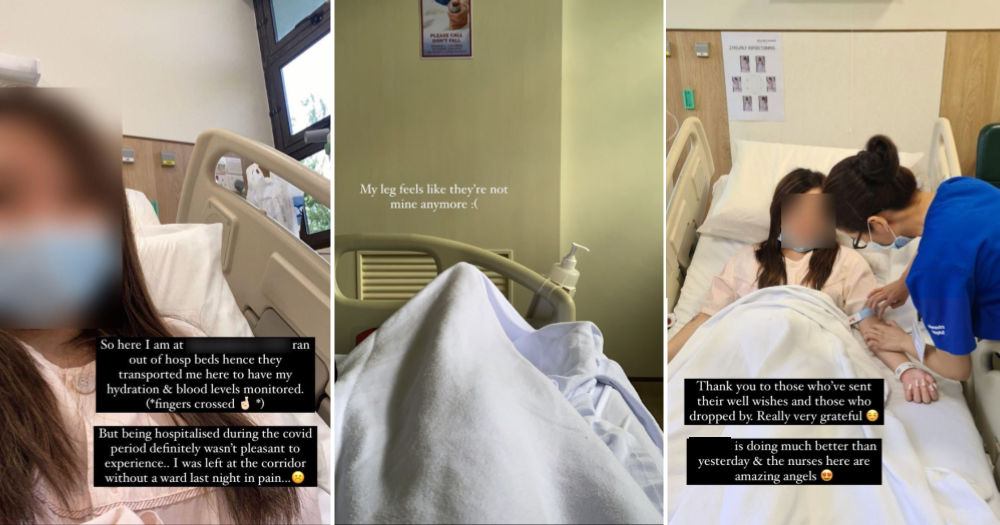When an opportunity to attend her first-ever spin class came up, Michelle (not her real name) readily agreed.
The 24-year-old was making good progress on her New Year's resolution; to start working out again, as she had stopped exercising regularly for the past six months due to the pace of her work picking up.
She would also have the company of two friends, regular spin class attendees.
Spin, an increasingly popular workout, gets its name from the moving wheels of static exercise bikes that its participants ride.
Her maiden experience was "actually quite fun", Michelle tells Mothership over the phone from her hospital room, where she is recuperating from an episode of rhabdomyolysis.
However, her chirpy demeanour belied the real danger she faced, just days ago.
What is Rhabdomyolysis?
Rhabdomyolysis, also known as "muscle breakdown" or rhabdo, happens when muscles are so injured or overworked that their fibres die, and by-product cells start to be released into the bloodstream.
It can be caused by physical trauma, such as a car accident, but can also happen to those who over-exert themselves during workouts, according to a Singapore Medical Journal article.
The article describes the sports-induced form of the syndrome as a "metabolic crisis" — where the body is unable to adequately process (or, metabolise) harmful substances.
This is brought about by muscle damage after prolonged exercise, and is "usually induced by strenuous eccentric exercises in a hot and humid environment."
Extreme cases of rhabdomyolysis may ultimately lead to kidney failure and even death.
What happened
The fateful spin class took place in the morning of Friday, Feb. 19.
Under the dimmed lights of a swanky downtown studio, and with pulsing, high-tempo music not unlike the tracks played in clubs, Michelle got her first taste of an experience she had seen many raving about on social media.
After the fun experience, Michelle headed to work right after.
Michelle thought little of the muscle soreness that set in the day after.
After all, she was no stranger to intense workouts, having been through gruelling physical training sessions in her days of practicing mixed martial arts (MMA).
Tell-tale signs
But by Monday morning, three days after the class, Michelle woke feeling extremely weak, and finding that she could not move her legs normally.
The initial soreness in her thigh muscles had also intensified into something like a severe cramp — a "more painful kind of muscle tearing" feeling.
"It really felt like my legs had been hit by a truck."
Stefanie (also not her real name), a 21-year-old undergraduate student, who also got rhabdomyolysis after attending her first spin class earlier in February, said that her pain tolerance is "pretty high".
But the pain she felt was so severe that she had to use ride-hailing service to get to classes from her hostel, and ordered food delivery as she was unable to walk to a canteen.
"It felt like it was burning actually, like with every stretch and with every step."
Like Michelle, Stefanie experienced the worst of it on the third day after her spin class.
Stefanie said that "there’s no specific telling symptom that distinguishes between a normal muscle ache and Rhabdo."
It was only when her urine changed colour that she sought medical attention, taking a taxi to a clinic, which then referred her to a hospital.
For Michelle, a creeping sense that something was wrong on the third day after her class would later be confirmed when she went to the toilet that evening.
She found that her urine was a dark "Coca-Cola colour", not because of blood, but because her body was trying to rid itself of the by-products of dying muscle tissue — one of the clearest symptoms of rhabdomyolysis.
Treatment options are limited
Michelle's treatment involved getting put on an intravenous (IV) drip to help prevent potentially harmful proteins from causing harm to her kidney.
Her condition was monitored closely, with daily blood tests.
The pain would get worse before it got better, Michelle said.
Five days after being warded, she is now able to walk, but still has trouble bending her knees.
Thankfully, Michelle is expected to make a full recovery, and is on track to be discharged sometime in the next few days, as the levels of harmful proteins in her blood have been declining day by day.
Her doctor's advice is to wait for around a month, before starting on light exercise.
Stefanie, whose doctors said her recovery would take one to two weeks, has been resting at home for the past four days.
She is now "much, much better", though she still feels sore after walking for longer distances.
Her quads are still "very weak". "Sometimes I feel like I'm going to fall," she said.
Warnings for first-timers weren't enough
“I guess it’s quite the trend nowadays, and I see it on Instagram quite often, so I wanted to try it out and get in shape," says Stefanie. "At the end of the day, I think it was an experience that I enjoyed."
But she wonders if the gym she visited could have done more to warn newcomers of the potential risks.
"I think there needs to be more attention paid to first timers, and to ensure that they know this condition might happen."
The gym, Michelle said, did not require her to go through any registration, nor inquire of her fitness level.
"I just went into the class," she told us.
While Michelle remembers that the class' instructor did advise first-timers not to push themselves too hard, she felt that the pace of the class was manageable.
Michelle now realises that there was something different about the spin session, as compared to any other workout she'd been in before.
Easy to get carried away
Spin class — or, at least the one she attended — had an atmosphere that made it all too easy for her to keep pedalling on the exercise bike, and to keep up with the pace of the class, despite her six-month hiatus from exercise.
"Honestly, the environment is quite fun, because everybody's exercising together... Everybody just moves together lah.
I think that's also one of the reasons why I didn't [feel] like I was tired, or like, it was too much for me."
Surrounded by fellow spin class attendees completing revolution after revolution, Michelle admits that she let herself "get carried away with... high-intensity workout kind of music."
"Your legs are in cleats and locked into the bike, said Stefanie. "And I think that contributes to not being able to tell whether you are over exerting or not."
Stefanie's experience with high-intensity interval training (HIIT) was that she "could regulate and modify the exercises, and stop when I felt like I couldn’t continue." With spin, however, "after a while, the bike starts to pull your legs to move instead."
Like what Michelle experienced, there was no tutorial or introduction for first-timers at Stefanie's spin session.
"I was just thrown into the deep end and I didn't know much about spinning and anything related to injuries that might happen."
"I think [the risk of rhabdomyolysis] is something that people should know about, before they start spinning," Stefanie added.
Not going back anytime soon
Stefanie won't be going back to spin "anytime soon", saying that her parents have "understandable" concerns after her harrowing experience.
Michelle, on the other hand, is not yet decided if she will go back at all, saying that "it's still quite scary to think about it."
One thing's for sure, though — when asked how she would advise someone seeking to get back to exercise like she was a week ago, Michelle said to "start with something that is lighter on the body."
"I think the worst idea is to go to a spin class."
Top photos courtesy of Michelle
If you like what you read, follow us on Facebook, Instagram, Twitter and Telegram to get the latest updates.

